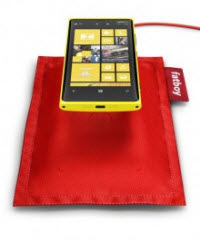Can Nokia take wireless charging mainstream?

Wireless charging is not new. Even the much-loved Palm Pre, released back in 2009, wasn't the first handset to have this feature baked into the device. Now, Nokia is hoping that its new Windows Phone 8-powered Lumia 920 will take wireless charging and make it mainstream.
Nokia has embraced the Wireless Power Consortium's standard called Qi -- the Chinese word for energy flow, pronounced "chee" -- and hopes that the attraction of being able to recharge a smartphone without having to juggle cables and fiddle connectors into charging ports will be enough to win over consumers.

Moreover, while the flagship Lumia 920 has Qi wireless charging built in, the lower-spec Lumia 820 will come with an optional wireless recharging shell. Even Nokia isn't certain enough of the interest in wireless charging to add it to both handsets.
The Finnish smartphone company has gone as far as collaborating with Fatboy to create a recharge pillow, and has partnered with Virgin Atlantic airline and Coffee Bean & Tea Leaf chain to make charging pads available to customers.
It's unlikely that Virgin Atlantic and Coffee Bean & Tea Leaf are making this hardware available to consumers out of the goodness of their own heart. This is a deal, and it's likely that Nokia is bankrolling it. Nokia is hoping that the social buzz created by people seeing wireless charging pads on airlines and in coffee shops will encourage people to buy Lumias over the competition.
Microsoft has a history of trying -- and, mostly failing -- to leverage the social aspects of hardware. Two recent examples are the Zune media player and Windows Phone 7. The Zune had a "sharing" feature that allowed the owner of one Zune to send a song to another Zune owner -- assuming the owner could find another Zune owner -- with a 3-day/3-play limitation.
At the core of the Windows Phone 7 operating system was "social sharing," where a Windows Phone 7 handset will become the hub for all the owner's social interactions.
Using new hardware -- with minimal market penetration -- doesn't work to create a buzz. That buzz has to be generated initially by making people want to buy the hardware, in other words, marketing. Then, people see other people using that hardware, and they want it. That's the point at which trying to leverage the social aspect of hardware -- when enough people have it to make it truly social.
Speaking to AllThingsD, Menno Treffers, chairman of the Wireless Power Consortium, said: "there's a real network effect in that the more products that have it [wireless charging], the more useful the feature becomes". He went on to say that: "the next step for wireless power is integrating Qi directly in mobile devices and in everyday spaces, so that you can take out your device at the coffee shop or in the center console of your car, for instance, and set it down to charge without wires".
This is a problem for Nokia. Qi is third-party technology -- like the Synaptics ClearPad touchscreen that enables gloved finger support -- and, as such, the Wireless Power Consortium wants to see it baked into as many products as possible. I'm betting that the consortium would love to get its technology into a mass-market smartphone like the iPhone. The consortium has no loyalty to Nokia. Getting into the Lumia 920 is a nice win, and if it doesn't end up being a profitable deal, the publicity will no doubt raise awareness of the technology.
It's unlikely that Nokia will take wireless charging and make it mainstream since the Lumia 920 is just one handset, and it's powered by Windows Phone, a virtual no-name compared to the iOS and Android mobile juggernauts. But this could well be the catalyst that raises awareness of wireless smartphone charging in the consciousness of the masses. And that could find it making its way into more smartphones, along with a range of other consumer electronic devices.
Whether that will take the technology and make it mainstream remains to be seen.
Image source: Nokia.